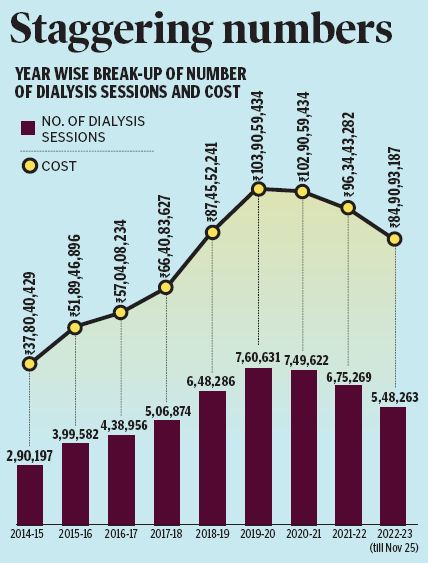Not only does the initiative provide better and safer alternatives for poor patients with chronic kidney disease, but it also successfully uses medical technology to address kidney disease, a major public health problem.
Post Date – 11:59 PM, Wednesday – 12/14/22

Not only does the initiative provide better and safer alternatives for poor patients with chronic kidney disease, but it also successfully uses medical technology to address kidney disease, a major public health problem.
Hyderabad: One of Telangana’s enduring technology-driven public healthcare initiatives that has been difficult for many other state governments to replicate is the continued provision of free dialysis facilities for poor patients, which has reached the milestone of a staggering 5 million free dialysis sessions in more than 80 government hospitals.
Not only does the initiative provide better and safer alternatives for poor patients with chronic kidney disease, but it also successfully uses medical technology to address kidney disease, a major public health problem.
In part, the initiative paved the way for state governments to offer poor patients a comprehensive kidney care package that includes three to four sessions of dialysis per week, free consultations with nephrologists, access to erythropoietin supplements, and Improvement of anemia status and their quality of life, registration of cadaveric donation kidney with Jeevandan, free kidney transplant facility in government hospitals, reimbursement up to Rs 1 million through Aarogyasri health insurance scheme, and life-long supply of medicines required after kidney transplant surgery.

A unique feature of the program is its ability to offer technically advanced dialysis classes for free. When it was launched in 2014-15, the average dialysis fee at a private hospital in Hyderabad used to hover between Rs 5,000 and Rs 8,000. With prohibitively high private sector costs, it’s a death sentence for poor chronic kidney disease patients who need regular dialysis but can’t afford it. As a result, most of these patients have difficulty persisting and give up, eventually leading to kidney failure and death.
At that time (2014-15), only 3 government hospitals, NIMS, Osmania General Hospital (OGH) and Gandhi Hospital, provided free dialysis services. Before the initiative, providing free kidney dialysis to patients in need on a large scale was unheard of, with the risk of rising infections and high costs at any time.
In order to reduce the cost of performing dialysis treatment and avoid the huge financial burden of purchasing expensive dialysis equipment, the state government works directly with international dialysis equipment manufacturers. As a result, despite the availability of high-end and expensive dialysis technology at the time, the Telangana government managed to provide a single dialysis session for kidney disease patients at a cost of less than Rs 1,500 and reimburse the dialysis manufacturers. The drastic reduction in the cost of performing a single dialysis session is also forcing private operators to think outside the box and reduce costs.
Techniques to reduce infection in dialysis patients:
Based on patient and carer experience and feedback, the state government also made the big decision to introduce single-use dialyzers, which are more expensive than regular dialyzers but can go a long way in reducing infections in people with kidney disease.
Until then, dialyzers and other medical tubing used for dialysis were used multiple times, which increased the risk of hepatitis infection for patients. With the advent of dialyzer technology, although it was expensive, state governments decided to adopt it to reduce infections and perform dialysis in a safe manner.
A component of a dialysis machine, a dialyzer is a man-made filter that contains tiny hollow fibers with tiny holes in their walls. These pores are called semi-dialysis membranes, and toxins are removed when dialysate flows through the artificial filter. Due to advancements in technology and innovation, the availability of disposable dialyzers has improved, enabling the health sector to use them on a large scale for all kidney patients.
